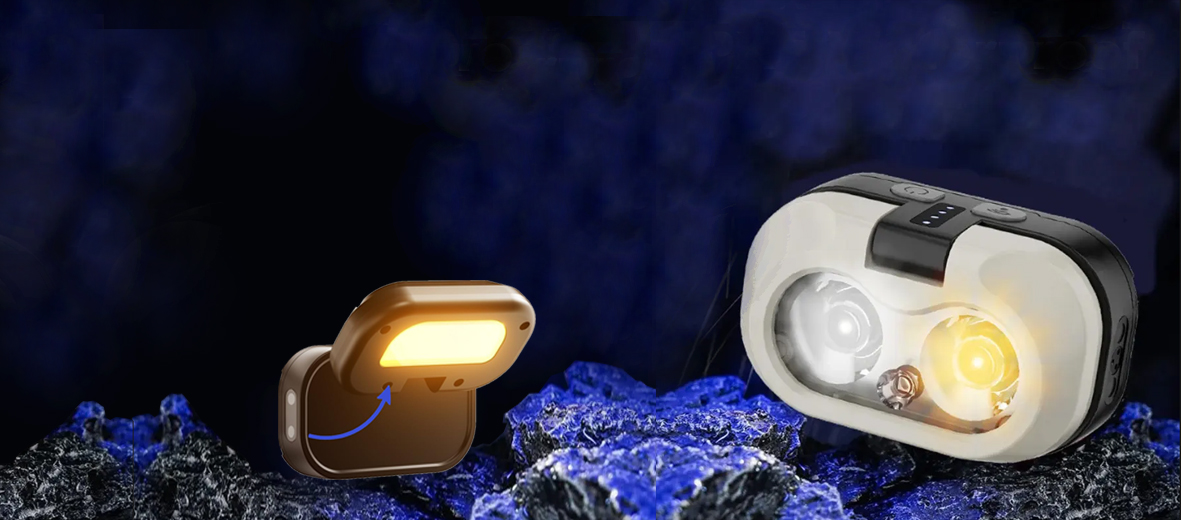Oil rigs present harsh conditions that demand specialized lighting equipment. Certified industrial headlamps oil rig workers use must resist chemicals, withstand shocks, and feature durable materials. These certifications, such as ATEX and IECEx, help ensure compliance with OSHA lighting requirements and protect employees from hazards. Proper headlamps illuminate critical work areas, support safety, and meet the unique demands of different rig zones.
| Feature | Importance |
|---|---|
| Resistance to Chemicals | Headlamps must withstand exposure to grease, oils, and other chemicals found on oil rigs. |
| Shockproof Design | Essential for safety, as headlamps may be dropped or bumped in a rugged environment. |
| Durable Materials | Use of hard-wearing polymer and rubber to absorb shocks and resist corrosion. |
Key Takeaways
- Certified headlamps are essential for oil rig safety. They prevent ignition in explosive environments, protecting workers from hazards.
- Always check for ATEX and IECEx certification markings on headlamps. These symbols confirm compliance with safety standards for hazardous zones.
- Select headlamps based on the specific hazardous zone classification. Different zones require different safety features to ensure compliance.
- Regularly inspect and replace certified headlamps. This practice maintains safety standards and helps avoid costly fines for non-compliance.
- Choose durable headlamps made from resistant materials. They must withstand harsh conditions, including exposure to chemicals and physical shocks.
ATEX and IECEx Certifications for Industrial Headlamps Oil Rig

ATEX Certification Explained
ATEX certification sets the standard for equipment used in explosive atmospheres within the European Union. The ATEX directive, officially known as Directive 2014/34/EU, requires manufacturers to design products that prevent ignition in hazardous environments. Industrial headlamps oil rig workers use must meet strict criteria for electrical safety, mechanical strength, and resistance to environmental factors. The ATEX marking on a headlamp indicates compliance with these requirements. Manufacturers test each product for durability and reliability before granting certification.
Tip: Always check for the ATEX symbol and classification code on the product label. This ensures the headlamp meets the necessary safety standards for explosive zones.
IECEx Certification Explained
IECEx certification provides a global framework for equipment safety in explosive atmospheres. The International Electrotechnical Commission (IEC) developed this system to harmonize standards across different countries. IECEx certification confirms that industrial headlamps oil rig workers use have passed rigorous testing for electrical and mechanical safety. The process involves independent assessment and ongoing surveillance of manufacturing practices. IECEx-certified headlamps display a unique certificate number and safety code, making it easy for safety managers to verify compliance.
| IECEx Certification Benefits | Description |
|---|---|
| Global Acceptance | Recognized in many countries outside the EU. |
| Transparent Process | Certification details available online. |
| Continuous Monitoring | Regular audits ensure ongoing compliance. |
Importance of Certification for Oil Rig Safety
Certification plays a vital role in protecting oil rig personnel from fire and explosion risks. Industrial headlamps oil rig environments present unique hazards, including flammable gases and dust. Certified headlamps reduce the chance of accidental ignition by using sealed housings and spark-resistant materials. Safety managers rely on ATEX and IECEx markings to select appropriate equipment for each hazardous zone. Regular inspection and replacement of certified headlamps maintain safety standards and support regulatory compliance.
Note: Certified headlamps not only protect workers but also help companies avoid costly fines and shutdowns due to non-compliance.
Differences Between ATEX and IECEx for Industrial Headlamps Oil Rig
Geographic Scope and Application
ATEX and IECEx certifications serve different regions and regulatory needs. ATEX certification applies within the European Union. It is mandatory for equipment used in explosive atmospheres, including oil rigs operating in EU waters. IECEx certification, on the other hand, functions as a voluntary international system. Many countries outside the EU recognize IECEx, making it suitable for global operations. Oil rig operators often select certification based on the location of their rigs and the legal requirements of that region.
Operators working in multiple countries may prefer IECEx-certified industrial headlamps oil rig environments require, as this certification streamlines compliance across borders.
Certification Process Comparison
The certification process for ATEX and IECEx differs in several key areas:
- ATEX Certification: Enforced by Ex Notified Bodies (ExNBs) within the EU. These bodies provide EU Type Examination Certifications and ensure compliance with strict regional regulations.
- IECEx Certification: Overseen by the IECEx Management Committee. This system uses a centralized database and a uniform process, but it does not have a single enforcing authority. The process promotes transparency and global acceptance.
| Certification | Regulatory Authority | Enforcement | Scope |
|---|---|---|---|
| ATEX | Ex Notified Bodies (EU) | Mandatory in EU | Regional (EU) |
| IECEx | IECEx Management Committee | Voluntary, Global | International |
Choosing the Right Certification for Your Oil Rig
Selecting the appropriate certification depends on several factors:
- Safety features required for explosive atmospheres
- Quality standards of certified products, which may impact reliability
- Intended application and the specific environments where the headlamps will be used
- Geographical relevance, as ATEX is legally binding in the EU, while IECEx offers broader international recognition
Oil rig operators should assess their operational locations and compliance needs. They must also consider the safety requirements of their teams. Choosing the right certification for industrial headlamps oil rig environments helps ensure both legal compliance and worker protection.
Hazardous Zones and Safety Standards for Industrial Headlamps Oil Rig
Hazardous Zone Classifications on Oil Rigs
International safety standards divide oil rig environments into hazardous zones based on the likelihood of explosive gases being present. Each zone has specific requirements for equipment safety. The table below outlines the main classifications and their implications for lighting equipment:
| Zone | Definition | Examples on FPSO | Equipment Requirement |
|---|---|---|---|
| 0 | Continuous Presence of Gas | Inside cargo tanks, slop tanks, inside vent masts | Must be intrinsically safe (Ex ia) |
| 1 | Frequent Presence of Gas | Pump rooms, turret and mooring systems, cargo tank vents | Explosion-proof (Ex d) or intrinsically safe (Ex ib) |
| 2 | Occasional Presence of Gas | Areas adjacent to Zone 1, around process areas | Non-sparking (Ex nA, Ex nC, or Ex ic) or encapsulated (Ex m) |
These classifications help safety managers identify where the risk of ignition is highest and guide the selection of compliant lighting solutions.
Certification Requirements by Zone
Hazardous area classification plays a critical role in determining the certification requirements for industrial headlamps oil rig workers use. Lighting fixtures in these zones must prevent any internal spark or flame from igniting the surrounding atmosphere. The requirements differ by zone:
- Zone 0 demands intrinsically safe headlamps, as explosive gases are always present.
- Zone 1 requires explosion-proof or intrinsically safe equipment, suitable for areas with frequent gas presence.
- Zone 2 allows for non-sparking or encapsulated headlamps, as the risk is lower but still present.
Proper classification ensures that headlamps meet the necessary safety standards and protect workers from fire or explosion hazards.
Impact on Headlamp Selection
Hazardous zone classification directly impacts the selection of industrial headlamps oil rig environments require. Safety managers must match the headlamp’s certification to the zone’s risk level. For example, only intrinsically safe headlamps should be used in Zone 0, while explosion-proof models may suffice in Zone 1. Non-sparking or encapsulated headlamps can be considered for Zone 2. This careful selection process helps maintain compliance and ensures worker safety in every area of the rig.
Tip: Always verify the certification marking on the headlamp before use in a hazardous zone. Proper selection reduces risk and supports regulatory compliance.
Selecting Certified Industrial Headlamps Oil Rig

Understanding Certification Markings
Certification markings on industrial headlamps oil rig workers use provide essential information about safety and suitability. Each marking indicates compliance with specific standards. For example, ATEX certification confirms adherence to European safety requirements for explosive atmospheres. UL certification applies to North American markets and categorizes equipment based on the presence of flammable gases, vapors, or dust. The following table summarizes common certification markings:
| Certification | Description |
|---|---|
| ATEX | Compliance with European safety standards for explosive atmospheres. |
| UL | Relevant for North America; categorizes equipment for hazardous locations. |
Manufacturers also include markings for temperature ratings, ingress protection, material requirements, and electrical protection. These details help safety managers select headlamps that prevent ignition and withstand harsh oil rig conditions.
Key Features of Certified Headlamps
Certified industrial headlamps oil rig environments require several distinguishing features. These headlamps use sealed construction, often rated IP66 or higher, to block dust and water. They incorporate low electrical and thermal output to minimize sparking risks. Non-sparking materials and robust safety mechanisms further enhance protection. The table below compares certified and non-certified models:
| Feature | ATEX/IECEx Certified Headlamps | Non-Certified Models |
|---|---|---|
| Certifications | ATEX, IECEx, UL | None |
| Temperature Ratings | Designed to avoid ignition | No specific ratings |
| Sealed Construction | IP66 or higher | Varies, often not sealed |
| Safety Mechanisms | Low electrical/thermal output | Higher risk of sparking |
| Application Suitability | Oil & gas, mining, etc. | General use only |
Certified headlamps also feature independent control switches for dual light options, chemical-resistant bodies, and secure grips. These attributes ensure reliable performance in hazardous zones.
Practical Selection Tips for Oil Rig Environments
Selecting the right headlamp involves several practical considerations. Safety managers should choose models with adjustable elastic straps and waterproof ratings, such as IP67. Light output should reach at least 100 lumens with a beam distance of 105 meters. Headlamps must withstand dust, grit, oil, and water. Look for certifications like Class I, Division 1 and ATEX Zone 0 for maximum safety. Explosion-proof designs help maintain safe operations and avoid regulatory penalties.
Tip: Always select lighting that meets compliance standards for hazardous locations. Certified headlamps support safe operations and protect workers from ignition risks.
ATEX and IECEx certified industrial headlamps play a vital role in oil rig safety. These headlamps offer explosion-proof lighting, durable construction, and compliance with strict safety standards. Operators should select headlamps based on hazardous zone requirements and certification markings.
| Benefit | Description |
|---|---|
| Explosion-Proof Lighting | Prevents ignition in areas with flammable gases or dust. |
| Durable Construction | Withstands harsh offshore conditions using corrosion-resistant materials. |
| Regulatory Compliance | Meets global safety standards, supporting safe operations and reducing insurance costs. |
Regular inspection and timely renewal of certified headlamps help maintain safety and protect workers in hazardous environments.
FAQ
What does ATEX certification mean for industrial headlamps?
ATEX certification confirms that a headlamp meets strict European safety standards for use in explosive atmospheres. This ensures the device will not ignite flammable gases or dust on oil rigs.
How can workers identify if a headlamp is IECEx certified?
Workers can check the product label for the IECEx mark and a unique certificate number. Manufacturers also provide certification details in the user manual and on their official websites.
Why do oil rigs require certified headlamps?
Certified headlamps reduce the risk of explosions by preventing sparks or heat buildup. Oil rigs contain flammable substances, so safety managers must use only certified lighting to protect workers and equipment.
Can a headlamp have both ATEX and IECEx certifications?
Yes. Some manufacturers design headlamps to meet both ATEX and IECEx standards. These products offer flexibility for operators working in multiple regions or under different regulatory requirements.
How often should certified headlamps be inspected or replaced?
Safety experts recommend regular inspections based on manufacturer guidelines. Workers should replace headlamps immediately if they show signs of damage or fail to meet certification standards.
Post time: Aug-29-2025
 fannie@nbtorch.com
fannie@nbtorch.com +0086-0574-28909873
+0086-0574-28909873





